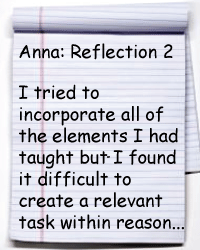
 Developing a Task Using RAFTERS
Developing a Task Using RAFTERS
 Creating a task meant to bring a learning unit to a culmination is not a simple procedure; it can seem impossible to incorporate all the elements into one activity. There is a process that teachers can follow that will help them design not only the task and its instructions (RAFTERS), but will also help the teacher decide how best to assess it; this process is called Task Analysis. Task Analysis is done early in the planning process; ideally, the final culminating task for a unit would be developed as part of the planning backwards process. Let’s look at what is involved in doing a task analysis and the benefits of such a process. Creating a task meant to bring a learning unit to a culmination is not a simple procedure; it can seem impossible to incorporate all the elements into one activity. There is a process that teachers can follow that will help them design not only the task and its instructions (RAFTERS), but will also help the teacher decide how best to assess it; this process is called Task Analysis. Task Analysis is done early in the planning process; ideally, the final culminating task for a unit would be developed as part of the planning backwards process. Let’s look at what is involved in doing a task analysis and the benefits of such a process. |
|
What are the steps involved in developing a task for the language classroom?
-
Create a sample product that you would like your students to create. Be as detailed as possible in the use of language so that you know what students need to be able to do.
-
Create a list of the materials that your students will need in order to create the product. Make sure to consider the use of technology and be thoughtful of what your students do or do not have access to.
-
Create a task analysis of your product. What do the students need to know in order to create the product? Consider all aspects including language, cultural knowledge, creative process, learning strategies, etc.
-
Create an assignment description using RAFTERS. Describe the project to the students using the RAFTERS acronym (See below).
-
Start planning backwards. Using the information gathered from the task analysis start to plan how you will teach each aspect of the project including linguistic elements, cultural elements, learning strategies, etc (Giving It). Think about how you will use Getting It and Using It activities to allow students to practice and apply what they are learning.
Why is completing RAFTERS and a task analysis important?
The teacher should always do the task before asking students to do the same thing. Having done this, the criteria will be more relevant, the teacher will be able to direct the students to what part of the task they should spend more time on, and the teacher will also be aware of what tools the students need to succeed. It is important to remember that these ‘tools’ include all of the language elements the students will need in order to complete the task, cultural awareness, and form-specific knowledge if applicable (for example, what a real estate advertisement from France should include). The teacher should not forget what the purpose of the task is and an appropriate emphasis should be placed on that purpose.
To successfully complete a task analysis, a teacher must create an exemplar of the task. This has several functions;
- It creates a visual example of the task. The teacher is able to see what is required to be part of the form (ie: visuals, title, cultural motif, cultural knowledge, language requirement)
- It lets the teachers know what the students have to do to complete the task. (ie: write the text, draw the pictures, structure an appropriate layout, add other necessary materials that are task specific)
- It gives the teacher a good idea of what the criteria for making the task should be. The teacher can better see where the most work was required. This is also where the teacher can make adjustments in the task requirements according to differentiation in the classroom. If the task is to create a CD cover, for example, students with more difficulties in the class can be required to include fewer songs, shorter descriptions, etc.
back to top
How do I create a task assignment using RAFTERS?
Watch the video to see the creation of a task assignment using RAFTERS. (time 11:12) |
The RAFTERS acronym can help to build a detailed and creative task for students:
Role – this is the role you assign to the students that they will be taking on in the task (ie: You are a travel agent)
Audience – this is the person who will be seeing/hearing/reading the task, so who the task is directed towards (ie: boss of the travel agency)
Form (text type) – this is the format in which the task should be created
(ie: travel brochure)
Topic – this is the subject matter of the task (ie: attracting tourists)
Engaging – this is the motivation for doing the task. What motivates the student to complete the task? (ie: best brochure will be chosen for publication)
Reason – this is where the purpose of the task is explained (ie: to create a brochure that will successfully attract North American tourists)
Strong verb(s) – this verb gives clear directions that cannot be misunderstood about what students are supposed to accomplish in the task. The verb doesn’t leave any ambiguity about what is expected from the students. (ie: write)
After the task has been planned using the RAFTERS acronym, the information can then be included in a short paragraph about the task followed by the criteria on which the students will be marked. Each criterion can be given point values based on the task analysis completed earlier in the process.
Example: Travel Brochure Task
You are a travel agent trying to attract North American tourists to your city. You will pitch your brochure idea to your boss. Choose relevant appealing visuals, organize them, and write short captions (2-3 sentences) for each image based on the following criteria …
General Criteria Categories
Presentation
Grammar
Quality of language (oral or written)
Relevance of images
Organization
back to top

Nunan, D. (2004) Task-based Language Teaching. Cambridge University Press, 2004











